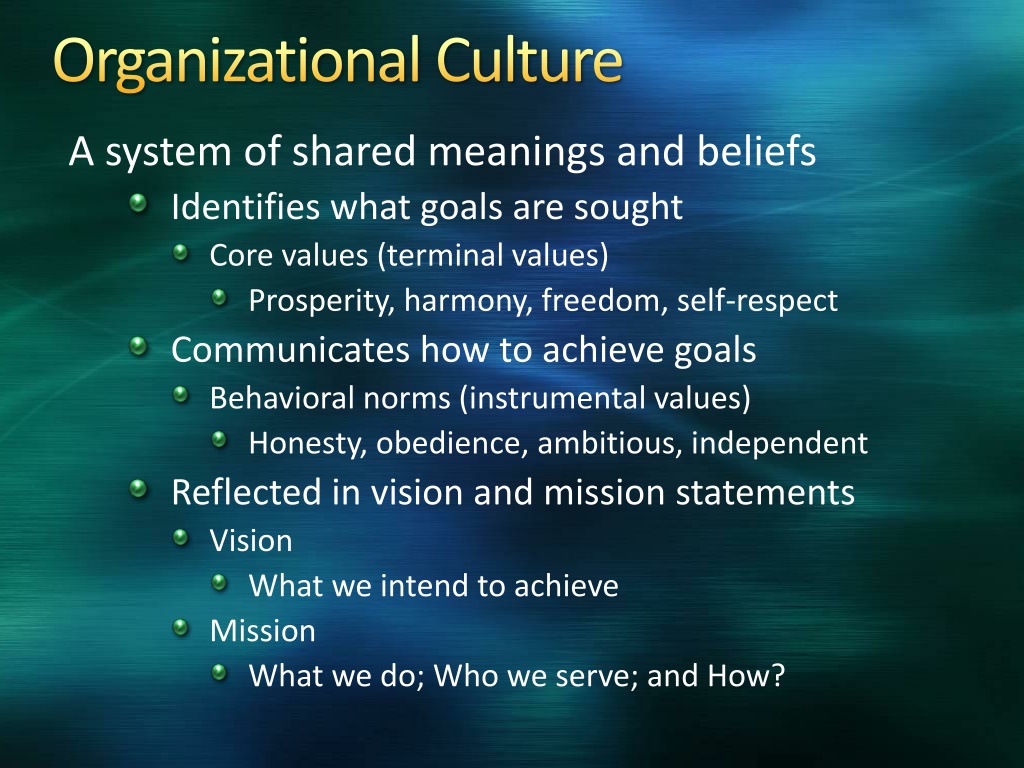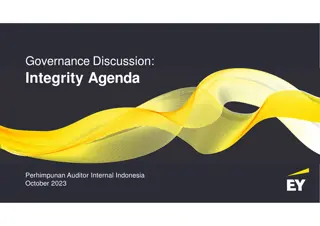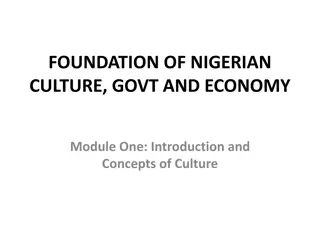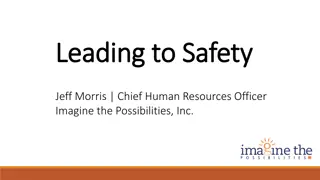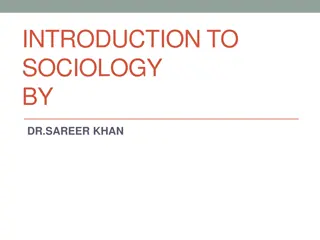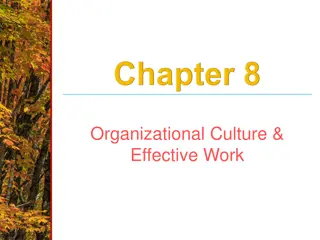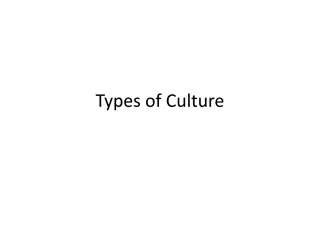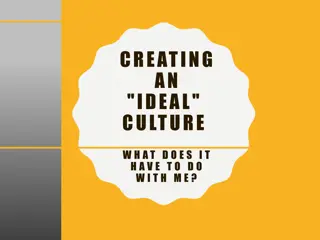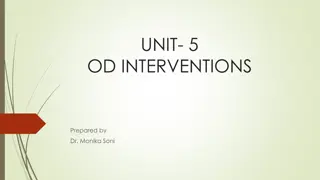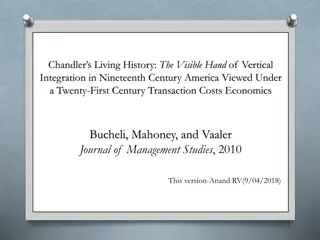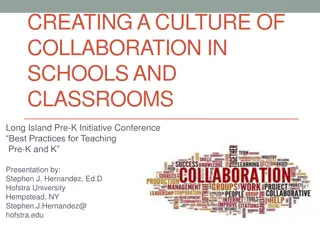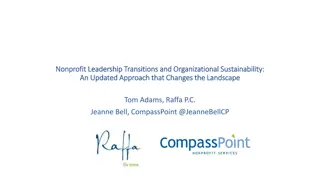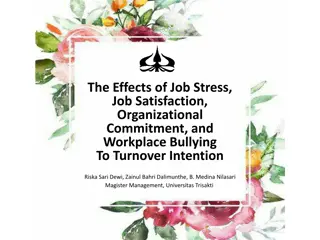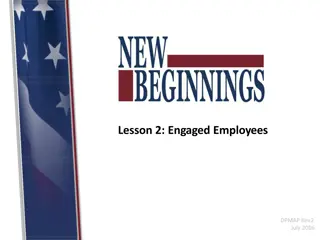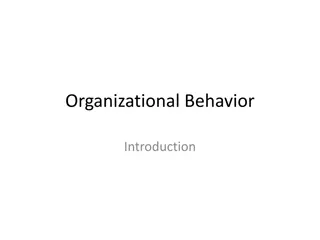Understanding Organizational Culture and Its Impact on Business Success
Organizational culture encompasses shared beliefs, values, and behaviors within a company. It influences goal-setting, strategies, and employee actions. The transmission of culture is vital for aligning values with business practices. Culture matters for client relations, differentiation, and managing discretionary behavior. Events, management, assumptions, and industry imperatives shape organizational culture. Requisite and discretionary values in different industries reflect cultural priorities. The ASA Model highlights the role of attraction in shaping organizational culture.
Uploaded on Sep 20, 2024 | 0 Views
Download Presentation

Please find below an Image/Link to download the presentation.
The content on the website is provided AS IS for your information and personal use only. It may not be sold, licensed, or shared on other websites without obtaining consent from the author. Download presentation by click this link. If you encounter any issues during the download, it is possible that the publisher has removed the file from their server.
E N D
Presentation Transcript
Organizational Culture A system of shared meanings and beliefs Identifies what goals are sought Core values (terminal values) Prosperity, harmony, freedom, self-respect Communicates how to achieve goals Behavioral norms (instrumental values) Honesty, obedience, ambitious, independent Reflected in vision and mission statements Vision What we intend to achieve Mission What we do; Who we serve; and How?
How is culture transmitted Explicit statements regarding values Vision & mission Forms: translate values into practice Permissible business strategies Differentiation, price competitive, niche identification Structures Centralization versus delegation (uniformity v specialization) Administrative Processes Compensation & performance management practices Firm-sponsored social organizations & communication Company softball team, Company parties, newsletters, celebrations Artifacts, Stories, Metaphors, Heroes, & Norms
When and Why Culture Matters Most Members represent firm to clients Culture as a social control mechanism and as a device to distinguish the firm from competitors Need to differentiate from competitors Direct supervision is difficult Member behavior is discretionary
What Determines Culture EVENTS 2008 Deepwater Horizon Chipotle Wells Fargo Management Forms strategy structure processes Assumptions Values Industry Environment customer requirements competition/munificence societal expectations CULTURE Prime beneficiaries or their agents may shape values consistent with assumptions Management develops the forms necessary to conduct business Culture and forms must conform to industry imperatives the right thing to do. electric utility financial services food services oil exploration Dotted lines = Influence Solid lines = Controlling influence Adapted from Gordon 1991
Requisite and Discretionary Values Service Vegan French Etc. Buffet Value Industry Imperative Aesthetics Non- Etc. Fast GMO Casual food Availability
How culture is preserved: ASA Model (The people make the place; Schneider, 1987) Attraction People are differentially attracted to careers as a function of their own interests and personality People maintain preferences for different Forms Selection (and Socialization) Organizations end up choosing people who share many common personal attributes Interviews, Realistic Job Previews, Personality tests person-organization fit via Value congruence Attrition Compatibles remain longer than Misfits Rosabeth Moss Kanter (Homosocial reproduction)
Cultural Types (SonnenfeldsTypology) Academy Baseball Team The Learning Organization The Natural Mastery - Careers Performance - Free agents knowledge, competence, specialization, training, silos outcomes, entrepreneurship, risk-taking, incentives Club Fortress The Family The Castle Conformity - Seniority Faithfulness - Knights loyalty, fitting in, experience, generalists, career lattices preoccupied with survival, defensive, messiah-silver bullet
Competing Values Framework COLLABORATE Human Relations - CLAN Focus: Values Situation: A community united by shared beliefs, competency is closely linked to unique abilities, lifestyle identification Purposes: Community and knowledge Practices: Building teams and developing communities, training, and coaching, creating shared vision and values, harmonious work environment People: Build trust, helpful, resolves conflict, empowering, good listener, encourages participation Environment: Harmonious atmosphere, collaborative workplace, informal communication, shared values Measures: Employee satisfaction, employee turnover, training per employee, peer review CREATE Open Systems - ADHOCRACY Focus: Vision Situation: Differentiation creates significantly higher margins, a new Methodology changes the game, an industry is situated around blockbuster invention Purposes: Innovation and Growth Practices: Encouraging radical thinking, launching new ventures, speculating emerging opportunities, launching change initiatives, destroying old practices People: Visionary, optimistic, generalist, enthusiastic, quick thinker, expressive Environment: Stimulating projects, flexible hours, free from everyday constraints, diverse workforce Measures: Diversity of experiments, new market growth, adoption rate, revenues from new products and services COMPETE Rational Goals - Market Focus: Goals Situation: Shareholder demands are the primary driver, aggressive competition, markets change from mergers and acquisitions, investors demand quick results Purposes: Profits and speed Practices: Managing performance through objectives, investing for increasing rates of return, quickly starting and killing initiatives, quickly confronting problems People: Goal oriented, assertive, driven, accountable, decisive, competitive Environment: High pressure, fast moving, quantifiable results, pay for performance Measures: Gross Profit, time to market, return on investment, operating income CONTROL - Processes - HIERARCHY Focus: Process Situation: Organization has large and complex scope and scale, government regulations and standards determine business practices, failure is no option Purposes: Efficiency and quality Practices: Implementing large scale technology and systems, applying continuous improvement processes, complying with regulations, adhering to standards People: Organized, methodical, technical, practical, objective, persistent Environment: Clear roles, logical objectives, structured work, cohesive work processes Measures: Budget adherence, milestones achieved, number of failures, regulatory compliance
CVF 4 Culture Types Hartnell, Ou, & Kinicki 2011
Cultural Types (Deal & Kennedys Typology) High Risk Low Risk Driving Outgoing High Risk & Fast Feedback Low Risk & Fast Feedback Fast Individualistic - objectives Team - activity Feedback police, construction, consulting, ad agencies Sales, retail stores, real estate, large computer firms Specialist Control High Risk & Slow Feedback Low Risk & Slow Feedback Slow Competence - ideas Conformity - process Feedback Aerospace, investment, Oil, military, high-technology Banks, insurance, utilities, accounting, public agencies
Culture Challenges The Challenge of Culture & personality Japanese auto companies in the US Trade imbalance circa 1980-90 Cultural differences between US and Japan Regional, personality, value & attitudinal
Culture Challenges The Challenge of a New Business Enterprise Walt Disney Company Family-friendly theme park @ Disneyland Disney Culture (cast members, security hosts, and guests) personal references: character physical appearance: grooming, conformity service orientation: enthusiasm, integrity
Purpose-Driven Culture A company s vision and mission communicates its purpose or raison d' tre Purpose-driven companies transmit a consistent message, bolstered by articulate values, that resonate with employees and customers Purpose-driven companies perform better Higher job satisfaction (79% to 19%) Strong financial performance (91% to 65%) Clearly defined culture & beliefs (89% to 38%) Survey of 3,300 executives by Deloitte concluded that culture was the most important issue they faced to assure success
Purpose Whole Foods To improve customer s health and well-being USAA (United Services Automobile Association) Supporting members of the military and their families Pentair (water purification & swimming pool equipment) To improve the quality of life for people around the world Saint Jude s Children s Research Hospital Advance cures, and means of prevention, for pediatric catastrophic diseases ASU College of Business To be recognized as a national leader in innovative, life-changing undergraduate and graduate business programs
The Google Bump Great perks at Google1 Offers paid time off for volunteering Onsite fitness center Paid Holidays 13 Paid Vacation 15 Discounted gym memberships Sick days Unlimited Onsite medical care facility 140 applicants per employee hire Offers college tuition reimbursement to employees Spouse receives salary for 10 years in event of employee death Free gourmet-quality dining But free gourmet-quality food is only a manifest benefit Instead, the intended purpose is to encourage employee relationships A common gathering spot Deliberate manipulation of service lines Deliberate crowding of diners seated at long tables Thus, employees bump into each other with frequency Ranked #1 Best place to work by Fortune in 2015 Ranked #1 Best place to work by Fortune in 2015
Functions & Dysfunctions of Culture Distinguishes one company from another Conveys a sense of identity among members Facilitates commitment to something larger than self- interest* Enhances social system stability Serves as a behavioral control mechanism Adopted culture may be misfit or maladaptive Perpetuates a spoils system* Encourages conformity Stokes conflict with subcultures Resistant to change
Summary Culture Enhances predictability of behavior Provides a common referent for employees Serves a unifying/integrative function Identifies the organization Requires management & investment Makes change more difficult Involves limited choice correspondent with industry assumptions May perpetuate dysfunction
